

News Archive Search. Free to Use and Reuse Sets This page features items from the Library's digital collections that are free to use and reuse.
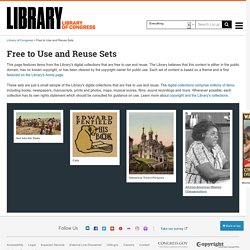
The Library believes that this content is either in the public domain, has no known copyright, or has been cleared by the copyright owner for public use. Each set of content is based on a theme and is first featured on the Library's home page. These sets are just a small sample of the Library's digital collections that are free to use and reuse.
University of the Arts and Teaching with Primary Sources. LIFE. Prints & Photographs Online Catalog. Photogrammar. TPS Teachers Network. TPS Teachers Network. Primary Source Sets. Articles. The Library of Congress’s albums. The Library of Congress. About The Library of Congress. Yes.
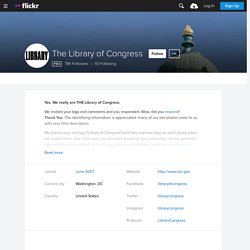
We really are THE Library of Congress. We invited your tags and comments and you responded. Wow, did you respond! Thank You. The identifying information is appreciated--many of our old photos came to us with very little description. We placed only one tag ("Library of Congress") and two machine tags on each photo when we loaded them. For more details on what we are doing, FAQs are available on the photos and newspapers and we are updating them as we learn more from our pilot. Flickr : The Library of Congress.
Chronicling America « Library of Congress. Science and Imagination: Full Steam(punk) Ahead with Primary Sources. Collecting cards with pictures of events in ballooning history from 1795 to 1846 Lately we’ve been oohing and aahing over the new Library of Congress online exhibition Finding Our Place in the Cosmos and sharing new science-related teaching resources with you.

Happily, thinking about other worlds isn’t just for science class! As seen in a recent blog post on 300 years of imaginary spaceships, not only scientists but writers and artists have been imagining fantastic possibilities for centuries. Primary Sources in Science Classrooms: Dimensions of Water Quality. This post was co-written by Trey Smith, the Library of Congress 2015-16 Science Teacher in Residence, and June Teisan, 2014-15 Albert Einstein Distinguished Educator Fellow.
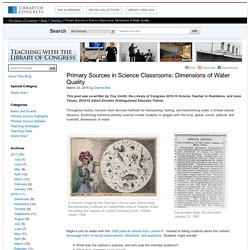
Throughout history, humans have devised methods for transporting, testing, and transforming water, a limited natural resource. Examining historical primary sources invites students to grapple with the local, global, social, political, and scientific dimensions of water. Begin a unit on water with this 1828 political cartoon from London. Primary Sources in Science Classrooms: Invasive Species and Historic Newspapers from Chronicling America.
This post was written by Trey Smith, the Library of Congress 2015-16 Science Teacher in Residence.
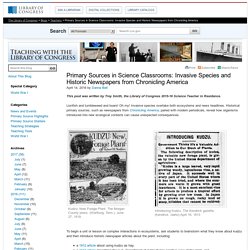
Lionfish and tumbleweed and boars! Oh my! Invasive species overtake both ecosystems and news headlines. Historical primary sources, such as newspapers from Chronicling America, paired with modern periodicals, reveal how organisms introduced into new ecological contexts can cause unexpected consequences. Primary Sources in Science Classrooms: Coal River and Human Impacts on Earth’s Systems. This post was written by Trey Smith, the Library of Congress 2015-16 Science Teacher in Residence.

Pollution haze hanging over the valley. Mary Hufford, 1995 Individually and collectively humans exert both positive and negative influences on Earth’s systems. Teachers and students studying the interactions among Earth’s atmosphere, hydrosphere, geosphere, and biosphere and related human activity can explore images, manuscripts, and recorded oral history interviews from the Coal River community in West Virginia. The Coal River Folklife Collection includes 718 sound clips, 1,256 photographs, and 10 manuscripts collected and curated by the Library’s American Folklife Center between 1992 and 1999.
Begin a series of lessons or a unit on human interactions with Earth’s systems by facilitating a student-driven analysis of a photo showing a stretch of the Coal River watershed. Where and when was this photo taken? Primary Sources in Science Classrooms: Size, Scale, and Scientific Communication. This post was written by Trey Smith, the Library of Congress 2015-16 Science Teacher in Residence.
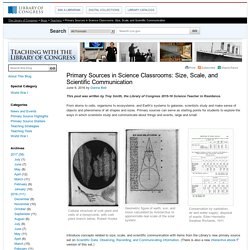
From atoms to cells, organisms to ecosystems, and Earth’s systems to galaxies, scientists study and make sense of objects and phenomena of all shapes and sizes. Primary sources can serve as starting points for students to explore the ways in which scientists study and communicate about things and events, large and small. Introduce concepts related to size, scale, and scientific communication with items from the Library’s new primary source set on Scientific Data: Observing, Recording, and Communicating Information.
(There is also a new interactive ebook version of this set.) Texts in the set include: Getting Right to the Source with Science-Related Primary Sources from the Library of Congress. Did you know that the Library’s education specialists write a column titled “Right to the Source” in The Science Teacher, a magazine published by the National Science Teachers Association?
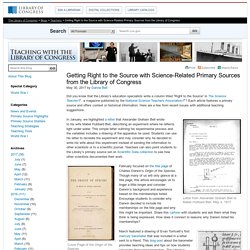
Each article features a primary source and offers context or historical information. Here are a few from recent issues with additional teaching suggestions. Letter from Alexander Graham Bell to Mabel Hubbard Bell, May 4, 1917 In January, we highlighted a letter that Alexander Graham Bell wrote to his wife Mabel Hubbard Bell, describing an experiment where he reflects light under water. This simple letter outlining his experimental process and the variables includes a drawing of the apparatus he used.
Exhibitions and Presentations - Nature and the Environment - Themed Resources. Teachers.
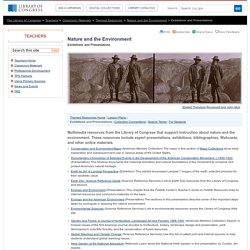
Today in History - April 22. Exhibitions and Presentations - Science and Invention - Themed Resources. Multimedia resources from the Library of Congress that support instruction about science and invention.
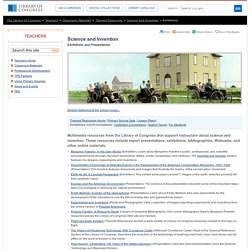
Today in History - April 22. Today in History - July 12. Writer, philosopher, and naturalist Henry David Thoreau was born on July 12, 1817, in Concord, Massachusetts. Associated with the Concord-based literary movement called New England Transcendentalism, he embraced the Transcendentalist belief in the universality of creation and the primacy of personal insight and experience. Thoreau’s advocacy of simple, principled living remains compelling, while his writings on the relationship between people and the environment helped define the nature essay. After graduating from Harvard in 1837, Thoreau held a series of odd jobs. Map of the town of Concord, Middlesex County Mass. Rights assessment is your responsibility. The maps in the Map Collections materials were either published prior to 1922, produced by the United States government, or both (see catalogue records that accompany each map for information regarding date of publication and source).
The Library of Congress is providing access to these materials for educational and research purposes and is not aware of any U.S. copyright protection (see Title 17 of the United States Code) or any other restrictions in the Map Collection materials. Note that the written permission of the copyright owners and/or other rights holders (such as publicity and/or privacy rights) is required for distribution, reproduction, or other use of protected items beyond that allowed by fair use or other statutory exemptions. Responsibility for making an independent legal assessment of an item and securing any necessary permissions ultimately rests with persons desiring to use the item.
Understanding the Cosmos: Changing Models of the Solar System and the Universe - Primary Source Set. Scientific Data: Observing, Recording, and Communicating Information - Primary Source Set. Skip navigation Library of Congress Teachers Suggestions enabled. About this Collection - Posters: WPA Posters. This collection consists of 907 posters produced from 1936 to 1943 by various branches of the WPA. Of the 2,000 WPA posters known to exist, the Library of Congress's collection of more than 900 is the largest.
The posters were designed to publicize exhibits, community activities, theatrical productions, and health and educational programs in seventeen states and the District of Columbia, with the strongest representation from California, Illinois, New York, Ohio, and Pennsylvania. The results of one of the first U.S. Government programs to support the arts, the posters were added to the Library's holdings in the 1940s. Background and Scope. About this Collection - Farm Security Administration/Office of War Information Color Photographs. Photographers working for the U.S. government's Farm Security Administration (FSA) and later the Office of War Information (OWI) between 1939 and 1944 made approximately 1,600 color photographs that depict life in the United States, including Puerto Rico and the Virgin Islands.
The pictures focus on rural areas and farm labor, as well as aspects of World War II mobilization, including factories, railroads, aviation training, and women working. The original images are color transparencies ranging in size from 35 mm. to 4x5 inches. They complement the better-known black-and-white FSA/OWI photographs, made during the same period [view information about the black-and-white FSA/OWI photographs]. The Library of Congress is sharing the FSA/OWI Color Photographs on Flickr, where Flickr community members add comments, notes, and tags. [View FSA/OWI Color Photographs on Flickr External | View more information about this project]. About this Collection - Prokudin-Gorskii Collection. Features color photographic surveys of the vast Russian Empire made between ca. 1905 and 1915. Prokudin-Gorskii Collection - About this Collection - Prints & Photographs Online Catalog (Library of Congress)
All images are digitized | All jpegs/tiffs display outside Library of Congress | View All The Sergei Mikhailovich Prokudin-Gorskii Collection features color photographic surveys of the vast Russian Empire made between ca. 1905 and 1915. The Evolution of the Conservation Movement, 1850-1920. TPS Teachers Network - The Arts and Primary Sources. Documents. Primary Sources. Society of American Archivists.
Primary Sources in the Classroom. The Gilder Lehrman Collection. Smithsonian Institution Archives. Objectives | Definitions | Instructions for Teachers | Instructions for Students | Comparing Types of Primary Sources Activity | Additional Resources. Primary Sources. Primary Sources. Primary Source Sets. Finding Primary Sources for Teachers and Students. Primary Sources from DocsTeach Thousands of online primary source documents from the National Archives to bring the past to life as classroom teaching tools.
National Archives Catalog Find online primary source materials for classroom & student projects from the National Archive's online catalog (OPA). Beginning Research Activities Student activities designed to help you navigate the National Archives resources and web site. Online Exhibits Exhibits featuring online documents, photos and primary sources from the National Archives Our Documents 100 Milestone Documents of American History Getting Started with Research How to start researching records at the National Archives. Primary Sources on the Web: Finding, Evaluating, Using. This brief guide is designed to help students and researchers find and evaluate primary sources available online.
Keep in mind as you use this website, the Web is always changing and evolving. Primary Sources at Yale. Primary Sources: What Are They? National History Day, an annual program for elementary and secondary students designed to "teach essential historical literacy that motivates students to secure the future of democracy," defines primary sources as follows: What is a primary source? Primary sources are materials directly related to a topic by time or participation. Online Curriculum - Primary Source. Teacher's Guides and Analysis Tool. Teaching Tolerance - Diversity, Equity and Justice. TPS Teachers Network - Primary Sources. Beyond the Bubble - Accessing 21st Century Skills with LOC Documents.
Civil Rights Movement in Context. Teachers - Overview - After Reconstruction - Lesson Plan. Back to Lesson Plans Lesson Overview The collection African American Perspectives: Pamphlets from the Daniel A.P. Overview - Segregation: From Jim Crow to Linda Brown - Lesson Plan. Back to Lesson Plans. Overview - Baseball, Race Relations and Jackie Robinson - Lesson Plan.
Overview - Baseball, Race and Ethnicity: Rounding the Bases - Lesson Plan. Overview - To Kill A Mockingbird - Lesson Plan. Overview - African American Identity in the Gilded Ag - Lesson Plan. Teacher Resource: Inquiry & Primary Sources Overview Webcast. The Teaching with Primary Sources Journal- Teaching with Primary Sources. Chronicling America « Library of Congress.